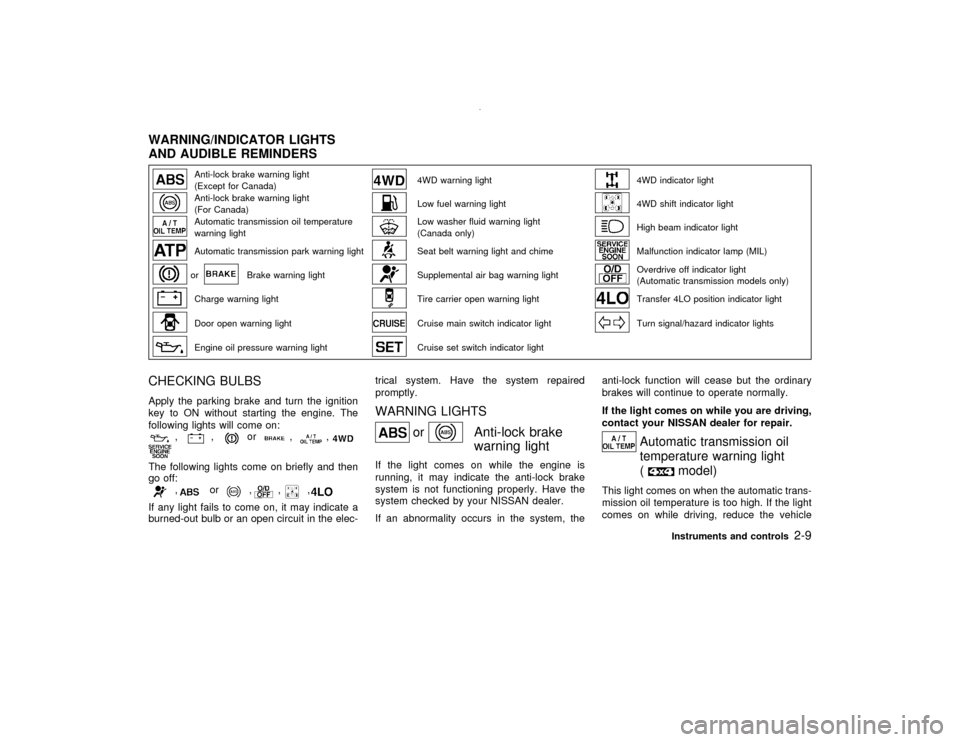fuel pressure NISSAN PATHFINDER 2001 R50 / 2.G Owners Manual
[x] Cancel search | Manufacturer: NISSAN, Model Year: 2001, Model line: PATHFINDER, Model: NISSAN PATHFINDER 2001 R50 / 2.GPages: 289, PDF Size: 2.45 MB
Page 62 of 289

Anti-lock brake warning light
(Except for Canada)
4WD warning light
4WD indicator light
Anti-lock brake warning light
(For Canada)
Low fuel warning light
4WD shift indicator light
Automatic transmission oil temperature
warning light
Low washer fluid warning light
(Canada only)
High beam indicator light
Automatic transmission park warning light
Seat belt warning light and chime
Malfunction indicator lamp (MIL)
or
Brake warning light
Supplemental air bag warning light
Overdrive off indicator light
(Automatic transmission models only)
Charge warning light
Tire carrier open warning light
Transfer 4LO position indicator light
Door open warning light
Cruise main switch indicator light
Turn signal/hazard indicator lights
Engine oil pressure warning light
Cruise set switch indicator light
CHECKING BULBSApply the parking brake and turn the ignition
key to ON without starting the engine. The
following lights will come on:
,
,
or
,
,
The following lights come on briefly and then
go off:
,
or
,
,
,
If any light fails to come on, it may indicate a
burned-out bulb or an open circuit in the elec-trical system. Have the system repaired
promptly.
WARNING LIGHTS
or
Anti-lock brake
warning light
If the light comes on while the engine is
running, it may indicate the anti-lock brake
system is not functioning properly. Have the
system checked by your NISSAN dealer.
If an abnormality occurs in the system, theanti-lock function will cease but the ordinary
brakes will continue to operate normally.
If the light comes on while you are driving,
contact your NISSAN dealer for repair.
Automatic transmission oil
temperature warning light
(
model)
This light comes on when the automatic trans-
mission oil temperature is too high. If the light
comes on while driving, reduce the vehicle
WARNING/INDICATOR LIGHTS
AND AUDIBLE REMINDERS
Instruments and controls
2-9
Z
00.1.10/R50-D/V5
X
Page 112 of 289

do not smoke or allow open flames or
sparks near the vehicle when refuel-
ing.
IFuel may be under pressure. Turn the
cap one-half turn, and wait for any
hissing sound to stop to prevent fuel
from spraying out and possible per-
sonal injury. Then remove the cap.
IDo not attempt to top off the fuel tank
after the fuel pump nozzle shuts off
automatically. Continued refueling
may cause fuel over-flow, resulting in
fuel spray and possibly a fire.
IOnly use an original equipment type
fuel filler cap as a replacement. It has
a built-in safety valve needed for
proper operation of the fuel system
and emission control system. An in-
correct cap can result in a serious
malfunction and possible injury or it
may cause the MIL to illuminate.
INever pour fuel into the throttle body
to attempt to start your vehicle.
CAUTION
IIf fuel is spilled on the vehicle body,
flush it away with water to avoid paint
damage.
ITighten until the fuel filler cap clicks.
Failure to tighten the fuel filler cap
properly may cause the
mal-
function indicator lamp (MIL) to illu-
minate. If the
lamp illuminates
because the fuel filler cap is loose or
missing, tighten or install the cap and
continue to drive the vehicle. The
lamp should turn off after a few
driving trips. If the
lamp does
not turn off after a few driving trips,
have the vehicle inspected by an au-
thorized NISSAN dealer.
IFor additional information, see the
ªMalfunction indicator lamp (MIL)º in
the ª2. Instruments and controlsº
section.Put the fuel filler cap on the cap holder while
refueling.
SPA0342
Pre-driving checks and adjustments
3-13
Z
00.1.10/R50-D/V5
X
Page 127 of 289

: Air flow mainly from foot outlets.: Air flow from defroster and foot outlets.
To turn the system offPush the OFF button.OPERATING TIPSIWhen the engine coolant temperature and
outside air temperature are low, the air flow
from the foot outlets may not operate for 0
to 126 seconds. This is not a malfunction.
After the coolant temperature warms up, air
flow from the foot outlets will operate nor-
mally.
The sensor on the instrument panel helps
maintain a constant temperature. Do not put
anything on or around this sensor.The air conditioning system in your NISSAN
vehicle is charged with a refrigerant designed
with the environment in mind.
This refrigerant will not harm the earth's
ozone layer.
However, special charging equipment and lu-
bricant are required when servicing your
NISSAN air conditioner. Using improper refrig-
erants or lubricants will cause severe damage
to your air conditioning system. See ªCapaci-
ties and recommended fuel/lubricantsº in the
ª10. Technical and consumer informationº sec-
tion for air conditioning system refrigerant and
lubricant recommendation.
Your NISSAN dealer will be able to service
your environmentally friendly air conditioning
system.
WARNING
The air conditioner system contains re-
frigerant under high pressure. To avoid
personal injury, any air conditioner ser-
vice should be done only by an experi-
enced technician with proper equip-
ment.
SAA0158
SERVICING AIR CONDITIONER
4-10
Heater, air conditioner and audio systems
Z
00.1.10/R50-D/V5
X
Page 164 of 289

During the first 1,000 miles (1,600 km), follow
these recommendations for the future reliabil-
ity and economy of your new vehicle.
IAvoid driving for long periods at constant
speed, either fast or slow.
IDo not accelerate at full throttle in any gear.
IAvoid quick starts.
IAvoid hard braking as much as possible.
IDo not tow a trailer for the first 500 miles
(800 km).
IAccelerate slowly and smoothly. Maintain
cruising speeds with a constant accelerator
position.
IDrive at moderate speeds on the highway.
Driving at high speed will lower fuel
economy.
IAvoid unnecessary stopping and braking.
Maintain a safe distance behind other ve-
hicles.
IUse a proper gear range which suits road
conditions. On level roads, shift into high
gear as soon as possible.
IAvoid unnecessary engine idling.IKeep your engine tuned up.
IFollow the recommended periodic mainte-
nance schedule.
IKeep the tires inflated at the correct pres-
sure. Low pressure will increase tire wear
and waste fuel.
IKeep the front wheels in correct alignment.
Improper alignment will cause increased
tire wear and lower fuel economy.
IAir conditioner operation lowers fuel
economy. Use the air conditioner only when
necessary.
IWhen cruising at highway speeds, it is
more economical to use the air conditioner
and leave the windows closed to reduce
drag.
I
Use 4H or 4L position only when neces-
sary. Four wheel drive operation lowers fuel
economy.
SD0001
BREAK-IN SCHEDULE INCREASING FUEL ECONOMY
Starting and driving
5-19
Z
00.1.10/R50-D/V5
X
Page 207 of 289

When performing any inspection or mainte-
nance work on your vehicle, always take care
to prevent serious accidental injury to yourself
or damage to the vehicle. The following are
general precautions which should be closely
observed.
WARNING
IPark the vehicle on a level surface,
apply the parking brake securely and
block the wheels to prevent the ve-
hicle from moving. For a manual
transmission, move the shift lever to
Neutral. For an automatic transmis-
sion, move the selector lever to the P
(Park) position.
IBe sure the ignition key is in the OFF
or LOCK position when performing
any replacement or repair.
IIf you must work with the engine
running, keep your hands, clothing,
hair and tools away from moving fans
belts and any other moving parts.
IIt is advisable to secure or remove
any loose clothing and any jewelry,such as rings, watches, etc. before
working on your vehicle.
IAlways wear eye protection when-
ever you work on your vehicle.
IIf you must run the engine in an
enclosed space such as a garage, be
sure there is proper ventilation for
exhaust gases to escape.
INever get under the vehicle while it is
supported only by a jack. If it is nec-
essary to work under the vehicle,
support it with safety stands.
IKeep smoking materials, flame and
sparks away from fuel and battery.
IYour vehicle is equipped with an au-
tomatic engine cooling fan. It may
come on at any time without warning,
even if the ignition key is in the OFF
position and the engine is not run-
ning. To avoid injury, always discon-
nect the negative battery cable before
working near the fan.
IOn gasoline engine models with themultiport fuel injection (MFI) system,
the fuel filter or fuel lines should be
serviced by a NISSAN dealer because
the fuel lines are under high pressure
even when the engine is off.
CAUTION
IDo not work under the engine hood
while it is hot. Turn off the engine and
wait until it cools down.
INever connect or disconnect either
the battery or any transistorized com-
ponent connector while the ignition
key is on.
INever leave the engine or the auto-
matic transmission related compo-
nent harness connector discon-
nected while the ignition key is on.
IAvoid direct contact with used engine
oil and coolant. Improperly disposed
engine oil, engine coolant, and/or
other vehicle fluids can hurt the envi-
MAINTENANCE PRECAUTIONS8-2
Do-it-yourself
Z
00.1.10/R50-D/V5
X
Page 287 of 289

Ignition switch automatic transmission
models ......................................................... 5-6
Ignition switch manual transmission
models ......................................................... 5-7
Overdrive switch ........................................ 5-13
Power door lock switch ............................... 3-4
Turn signal switch ..................................... 2-22
T
Tachometer ....................................................... 2-4
Temperature display ......................................... 2-6
Temperature gauge, Engine coolant temperature
gauge ................................................................ 2-4
Theft (Nissan Vehicle Immobilizer System),
Engine start..................................................... 2-16
Three way catalyst ............................................ 5-3
Tilting steering wheel ...................................... 3-14
Tire
Flat tire ........................................................ 6-2
Uniform tire quality grading ..................... 10-20
Tires
Spare tire ................................................... 8-36
Tire chains ................................................. 8-34
Tire placard ............................................. 10-14
Tire pressure ............................................. 8-32
Tire rotation ............................................... 8-34
Type of tires .............................................. 8-33
wheel/tire size.......................................... 10-11
Wheels and tires ....................................... 8-32
Tonneau cover ................................................ 2-33
Top tether strap child restraints ...................... 1-40
Towing
Tow truck towing ....................................... 6-12Towing a trailer........................................ 10-16
Towing load/specification chart ............... 10-16
Towing safety .......................................... 10-18
Trailer towing ................................................ 10-16
Transceiver, Integrated HomeLink
Universal
Transceiver ..................................................... 2-40
Transfer case shifting procedures ......... 5-21, 5-23
Transmission
Automatic transmission fluid (ATF) ........... 8-13
Driving with automatic transmission.......... 5-10
Driving with manual transmission ............. 5-14
Transmission selector lever lock
release ....................................................... 5-13
Transmitter (See multi-remote control
system) ............................................................. 3-5
Traveling or registering your vehicle in another
country .......................................................... 10-12
Turn signal switch ........................................... 2-22
U
Underbody cleaning .......................................... 7-3
Uniform tire quality grading........................... 10-20
V
Vanity mirror light ............................................ 2-40
Vehicle
Dimensions and weights ......................... 10-11
Identification number (VIN) ..................... 10-12
Loading information ................................. 10-15
Vehicle recovery, (freeing a stuck vehicle)..... 6-15
Vehicle security system .................................. 2-15
Ventilators ......................................................... 4-2W
Warning, Hazard warning flasher switch ........ 2-23
Warning labels, Air bag warning labels .......... 1-20
Warning light
4WD warning light ..................................... 5-28
Air bag warning light ........................ 1-21, 2-12
Brake warning light.................................... 2-10
Door open.................................................. 2-11
Low fuel warning light ............................... 2-12
Seat belt warning light and chime............. 2-12
Warning/indicator lights and chimes ................. 2-9
Warranty, Emission control system
warranty ........................................................ 10-21
Washer switch
Rear window wiper and washer switch ..... 2-18
Windshield wiper and washer switch ........ 2-18
Washing ............................................................ 7-2
Waxing .............................................................. 7-2
Weights (See dimensions and weights) ....... 10-11
Wheel/tire size .............................................. 10-11
Wheels and tires ............................................. 8-31
Cleaning aluminum alloy wheels................. 7-3
Window washer fluid ....................................... 8-17
Window(s)
Cleaning ...................................................... 7-3
Power windows ......................................... 2-35
Windshield wiper and washer switch.............. 2-17
Wiper
Blades........................................................ 8-21
Rear window wiper and washer switch ..... 2-18
Windshield wiper and washer switch ........ 2-18
Z
00.1.10/R50-D/V5
X
11-6
Page 288 of 289

FUEL RECOMMENDATION:VG33E engine:
Your vehicle is designed to operate on un-
leaded gasoline with an octane rating of at
least 87 AKI (Anti-Knock Index) number (Re-
search octane number 91).
VQ35DE engine:
Your vehicle is designed to operate on un-
leaded gasoline with an octane rating of at
least 91 AKI (Anti-Knock Index) number (Re-
search octane number 96).
CAUTION
Using a fuel other than that specified
could adversely affect the emission con-
trol devices and systems, and could
also affect the warranty coverage.
Under no circumstances should a
leaded gasoline be used since this will
damage the three way catalyst.
For additional information, see ªCapacities and
recommended fuel/lubricantsº in the ª10.
Technical and consumer informationº section.
ENGINE OIL RECOMMENDATION:IAPI Certification Mark
IAPI grade SG/SH, Energy ConservingI&II
or API grade SJ, Energy Conserving.
IILSAC grade GF-I & GF-II.
ISAE 5W-30 viscosity oil is preferred for all
ambient temperatures.
See ªCapacities and recommended
fuel/lubricantsº in the ª10. Technical and con-
sumer informationº section for engine oil and
oil filter recommendation.COLD TIRE PRESSURES:See the tire placard affixed to the glove box.NEW VEHICLE BREAK-IN
PROCEDURES
RECOMMENDATION:During the first 1,000 miles (1,600 km) of
vehicle use, follow the recommendations out-
lined in the ªBreak-in scheduleº Information
found in the ª5. Starting and drivingº section of
this Owner's Manual. Follow these recommen-
dations for the future reliability and economy of
your new vehicle.
GAS STATION INFORMATION
Z
00.1.10/R50-D/V5
X